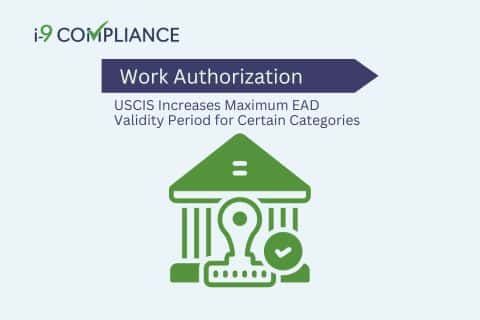USCIS Increases Maximum EAD Validity Period for Certain Work Authorization Categories

October 13, 2023
The U.S. Citizenship and Immigration Services (USCIS) has begun updating the agency’s Policy Manual to extend the maximum validity period for Employment Authorization Documents (EADs) to five years in multiple work authorization categories. Furthermore, the policy applies to initial and renewal documents and increases work authorization periods to a maximum of two years in several classifications.
Under this new policy, the USCIS will extend the maximum validity period for several categories of non-citizens. These categories include those who must apply for employment authorization. For example, those pending or granted asylum applications could extend their EADs. Others include withholding, deportation, or cancellation of removal and certain refugees.
This policy will also apply to those “admitted as refugees, paroled as refugees, and granted asylum, as well as recipients of withholding of removal.” Furthermore, the new guidance clarifies the documentation these individuals may present to complete the Employment Eligibility Verification (Form I-9) process.
The change to a five-year maximum validity period will apply to initial and renewal EADs for those covered by these changes. However, interested parties should remember that any EADs issued as replacements will not qualify. Though they will not display the extended timeframes, the new documents will maintain the same validity period as the replaced authorization documents.
The USCIS also noted other changes to the Policy Manual affecting foreign national workers. One such change concerns the Arrival/Departure Record (Form I-94). According to the agency, these workers may present Form I-94 as a List C document to employers. As such, Form I-94s qualify as proof of work authorization during the employment eligibility verification process. However, a List B document must accompany it to prove the individual’s identity and complete the verification process.
Allowing Form I-94 to qualify as a List C document and expanding the maximum validity period for EADs will also significantly benefit employers. These changes mean they can retain their employees longer, ensuring the business continues without struggling to find replacements. Furthermore, extending the time frame reduces the frequency of reverifying the foreign national workers’ employment eligibility.
Employers must continue ensuring compliance where the Form I-9 is concerned. This step continues to prove challenging, whether it means initial hiring or reverifying. One way to maintain compliance is by using an electronic I-9 management system. This system guides HR personnel through verification, eliminating many potential missteps. It also provides helpful reminders of when to take action and secure digital storage for I-9 documents.
Automate your employment eligibility verification today with the ensured compliance of I-9 Compliance.